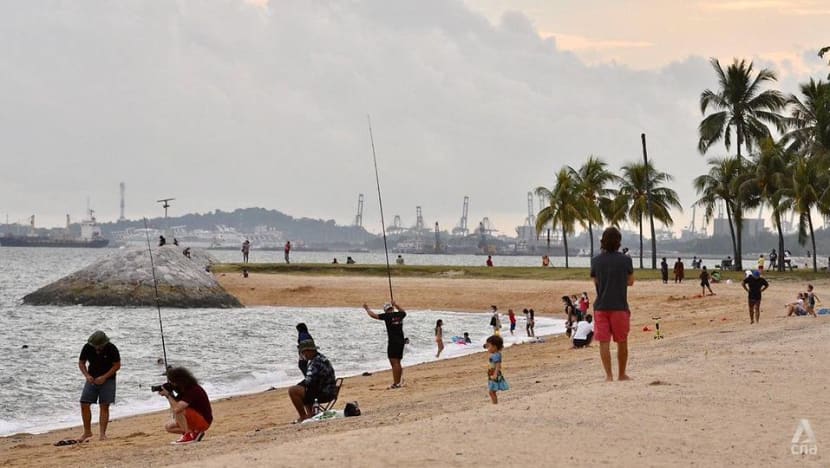Commentary: Coastal cities like Singapore face outsized risks – and opportunities – in a warming world
Many Southeast Asian cities are at the frontline for rapid, concerted and effective climate action, says the Intergovernmental Panel on Climate Change report's lead author Winston Chow.

Beachgoers at East Coast Park on the evening of Jun 19, 2020. (File photo: CNA/Jeremy Long)
SINGAPORE: The world’s coastal cities face a difficult future, no thanks to climate change. These locations will see the largest risks arising from heat extremes, droughts, floods, tropical cyclones and rising sea levels, as the world continues warming.
That’s one worrying conclusion from the latest assessment report on climate impacts and vulnerabilities from the Intergovernmental Panel on Climate Change (IPCC) that communities in coastal settlements must take heed of.
Released in late February, this report had a specific section on coastal cities and infrastructure, to shed light on the “so what?” of climate change in these vulnerable areas.
Much is at stake for people living in Southeast Asia’s coastal cities, especially when total urban populations in the region will almost double from 280 to 550 million people by the middle of this century.
Many people live in coastal megacities like Manila, Jakarta and Singapore. There are also big cities along major river mouths like Bangkok and Ho Chi Minh City, or small but rapidly-growing coastal settlements like Da Nang and Denpasar.
The concentration of human talent, built environment and transportation infrastructure in these cities are often massive engines of growth. Some estimates indicate that economic activities originating from these urban areas account for about 80 per cent of the region’s gross domestic product.

Worsening climate threats, such as sea-level rises submerging low-lying areas permanently or more frequent and intense tropical cyclones making landfall, could result in costly and devastating destruction to coastal livelihoods, infrastructure and property.
CASCADING CLIMATE RISKS
When climate change and coastal cities meet, the risks get increasingly complex. Beyond the direct damage immediately after a flood or tropical cyclone event, their effects can persist over time and create prolonged post-hazard periods.
We saw the cascading impact first-hand in December 2021 when Tropical Cyclone Rai (Odette) slammed into the Philippines, destroying millions of homes, and when extreme rainfall and flooding hit Peninsular Malaysia, displacing tens of thousands of people.
Coastal communities directly suffered immense catastrophic destruction during these storms, but the damage did not stay within city boundaries. Roads, rail lines, ports and airports were damaged, all of which required considerable time and money for repair, disrupting key urban transportation networks.
Not only was much-needed short-term aid for local communities impeded for days after the storms, but longer-term exports of goods through damaged ports were also disrupted for weeks. This cascaded across global supply chains and likely drove costs up for consumers and end-users.
In another instance, erratic weather in Malaysia wiped out crops early this year, which raised prices of fresh produce, including that exported to Singapore.
Climate cascading risks are difficult to manage and recover from and do not respect urban or national boundaries. In a warming world, we can expect weather-related extremes to create more shocks to global trade, particularly along vulnerable coastal areas.
ADDRESSING THE CAUSE OF CLIMATE CHANGE
With so much at stake today, coastal cities are certainly at the frontline of the forthcoming climate battle. So how can urban areas reduce or adapt to future climate risks?
Historically, low-lying cities like Singapore and Rotterdam have prioritised physical infrastructure. Improved drainage networks and tidal barrages help control floods, while sea walls or polder development protect coastlines from rising sea levels.
These approaches have worked before in reducing climate-related losses and damage and can be implemented at scale for a variety of coastal cities.
However, such ad hoc climate risk reduction will not succeed as global temperatures continue to rise beyond the Paris Climate Agreement warming limit of 1.5 degrees Celsius above pre-industrial temperatures.
When faced with a chronic illness, one shouldn’t deal only with the symptoms. Instead, addressing the underlying cause of the illness yields the best outcome.
Similarly, reducing climate risk by only protecting against one or two threats doesn’t address the cause of global warming.
What’s needed is climate-resilient development in cities. This approach combines infrastructure that adapts to climate hazards with actions reducing greenhouse gas emissions to mitigate climate change, as well as with policies improving livelihoods and well-being.
BUILDING CLIMATE-RESILIENT COMMUNITIES
The IPCC report assessed how climate-resilient development can be enabled from evidence across many cities. These options include not just using innovative engineering and technological approaches to reducing climate impacts, but also by protecting natural ecosystems.
For instance, coastal forests, mangroves, and seagrasses can protect against floods and sea-level rise. Unlike sea walls, these natural spaces reduce local temperatures and improve air quality, while allowing for recreation spaces for people, providing habitats for native flora and fauna and creating potential tourism opportunities.
Critically, conserving these natural spaces and integrating them into urban landscapes also mitigates greenhouse gas emissions and improves people’s livelihoods.
Further, legislating and investing in social policies could multiply the positive impacts of these urban “nature-based solutions”. In Semarang, Indonesia, several policies directly addressing flood and sea-level rise risks have been implemented to enhance climate-resilient development since 2009.
These include designating Semarang’s natural areas as marine wildlife reserves, zoning restrictions preventing coastal development along flood-prone shorelines, or including local or indigenous knowledge from marginalised communities most at-risk to climate hazards within decision-making processes.
Similar elements of a comprehensive climate-resilient approach can be seen in Singapore’s Green Plan 2030, where coastal protection (potentially S$100 billion invested by 2100) in adapting to sea-level rise and floods is a major focus.
The recent staggered increases in carbon taxes by 2030 and declaration of achieving net-zero GHG emissions by or around 2050 in recent Parliamentary Budget debates also indicates Singapore’s intent to play its role in mitigating climate change.
While Semarang, Singapore and other coastal cities like New York and Melbourne have made considerable progress towards climate resilience, others – particularly in less developed regions and for other Southeast Asian cities – are lagging behind despite looming coastal climate risks.
How does extreme weather affect the food you eat and the people who grow it? Listen to CNA's The Climate Conversations:
THE WINDOW FOR CLIMATE ACTION IS RAPIDLY CLOSING
The IPCC report’s key takeaway is that climate change is a threat to human well-being and planetary health. We are currently not on track for a sustainable world resilient to climate change. Any further inaction, or a lack of concerted global action, will likely mean considerable climate costs in the future.
Failing to expansively plan for climate change means planning to fail expensively, especially for coastal cities where up to US$14 trillion of infrastructure assets are exposed to climate change by 2100.
However, coastal cities are also at the frontline for rapid, concerted and effective climate action going beyond urban boundaries. As the IPCC report shows, some are taking steps in avoiding future loss and damage by comprehensively adapting to climate change while rapidly reducing emissions.
How other cities follow suit is important, as we do not want to miss a rapidly closing window of opportunity to secure a liveable future for many.
Winston Chow is an Associate Professor of Science, Technology and Society at Singapore Management University, and an IPCC Lead Author in their recently released Sixth Assessment Report on Impacts, Adaptation and Vulnerability.





















